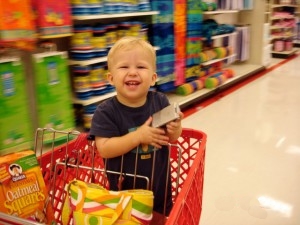How to Have a Happy Grocery Shopping Trip With Your Preschooler
 Is grocery shopping a nightmare for you? Fussy kids, grumpy mom, whining for Lucky Charms, strangers staring, coming home with the wrong items because you couldn't concentrate. Sound familiar?
Is grocery shopping a nightmare for you? Fussy kids, grumpy mom, whining for Lucky Charms, strangers staring, coming home with the wrong items because you couldn't concentrate. Sound familiar?
We used three simple rules that made grocery trips a whole lot smoother. We recited both the rules and the consequences together in the car before every shopping trip, because little ones can't always remember the rules from week to week. Kids also need to say the rules themselves, not just hear them.
Rule 1: Don't touch. For the safety of the children and the merchandise, kids are only allowed to touch what mom hands them. Let them help with anything they can't damage. They can put items in a child-sized basket or in the big basket.
Rule 2: Stay where you can see Mom. You need to state this from the child's perspective—a preschooler can't take someone else's perspective, so they don't know what it means if you say "Stay where I can see you." I did have to amend this rule with my son when he discovered that he could run around to the next aisle and peek between cereal boxes and still see me. When he figured that out, he was old enough to understand "Stay where you can see me and I can see you."
Rule 3: Don't ask for anything. My rule was that if the kids asked for something, the answer was always "no," even if I had been planning on buying it. This made things very simple and clear-cut. As children get older, you can get more nuanced, as in "You may ask, but if I say no, don't keep asking." This is too complex for a preschooler to understand, though.
An effective rule needs consequences. For us, being allowed to walk was a privilege, but if the kids did not follow rules 1 and 2, they had to ride in the cart. I did not treat this as a punishment—I still played games with them in the cart and sang songs; it was simply the loss of a privilege.
You will make things easier on yourself if you only give your child freedoms she is ready for. If she hasn't learned to come when you call her, don't let her walk on her own. If she will throw items, don't hand them to her. Teach her how to come when called, stay nearby, and treat items gently, and then you can give her more and more freedoms.
A few other tips will help ensure your shopping success:
Be prepared. Making a specific, detailed list before you head out the door will save your sanity when your attention is divided between your shopping and your kids.
Bring entertainment. A child-sized shopping cart can help your child work with you and stay engaged. Small toys in your purse will stretch attention spans when kids are riding in the cart. Snacks for the kids will help them stay happier longer. Plan to play I Spy, sing quietly together, play rhyming games, or let the kids try to find items that match pictures on the store flyer or coupons.
Choose your shopping time wisely. Shop at a time of day when the kids are generally happy. For me, that was morning, when their bellies were full from breakfast and they weren't nearing a naptime.
Grocery shopping is a necessity of life, but it can also provide a rich learning time for your children, as you count, match pictures to items, point out colors, letters, pictures, and words, and interact about what you are doing. Teaching your children a few rules about behavior in the store can help both of you enjoy shopping trips as quality time together.
Photo Credit: Doug Waldron cc
Related Posts
By accepting you will be accessing a service provided by a third-party external to https://mail.growthandgiggles.com/

